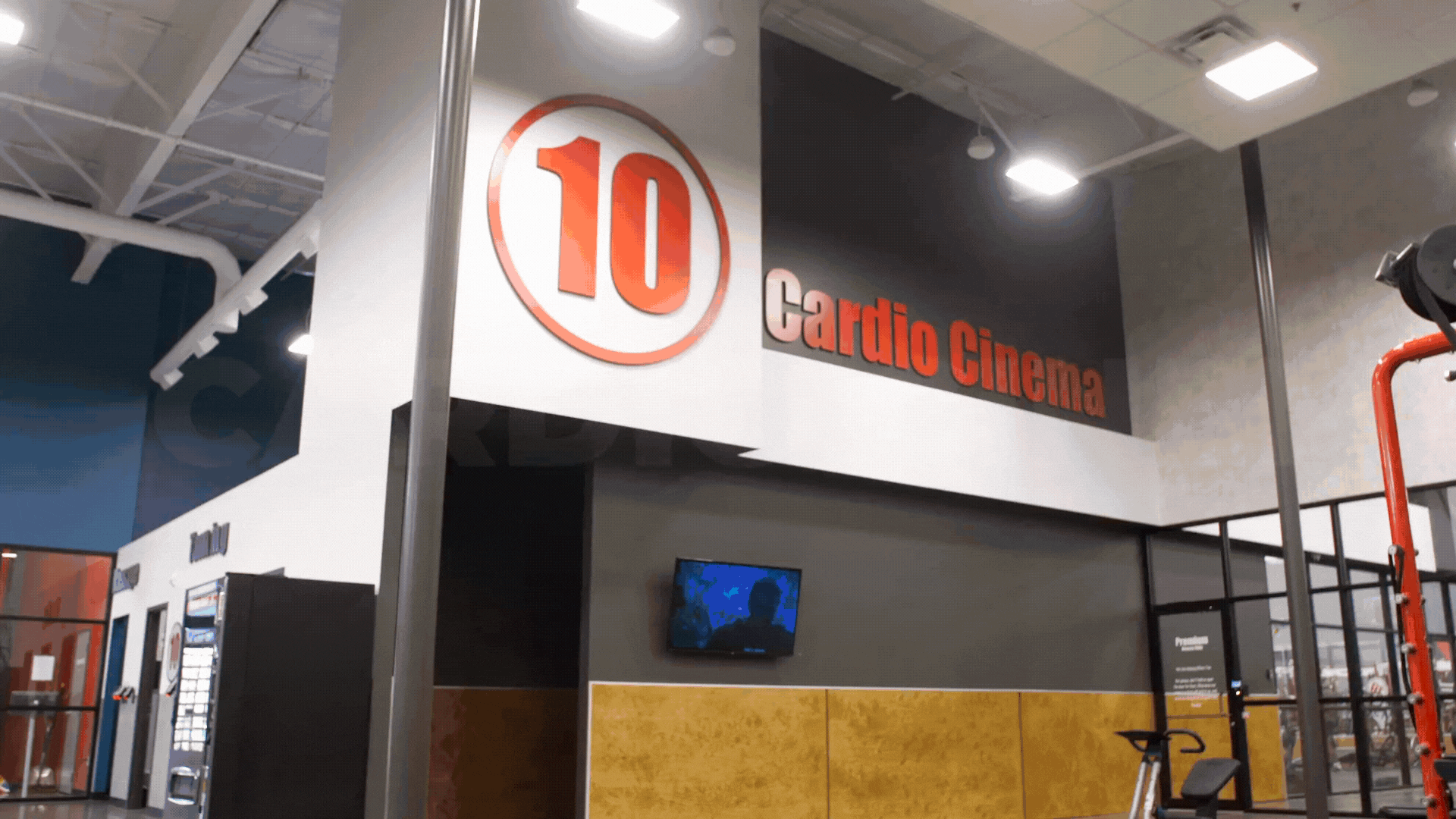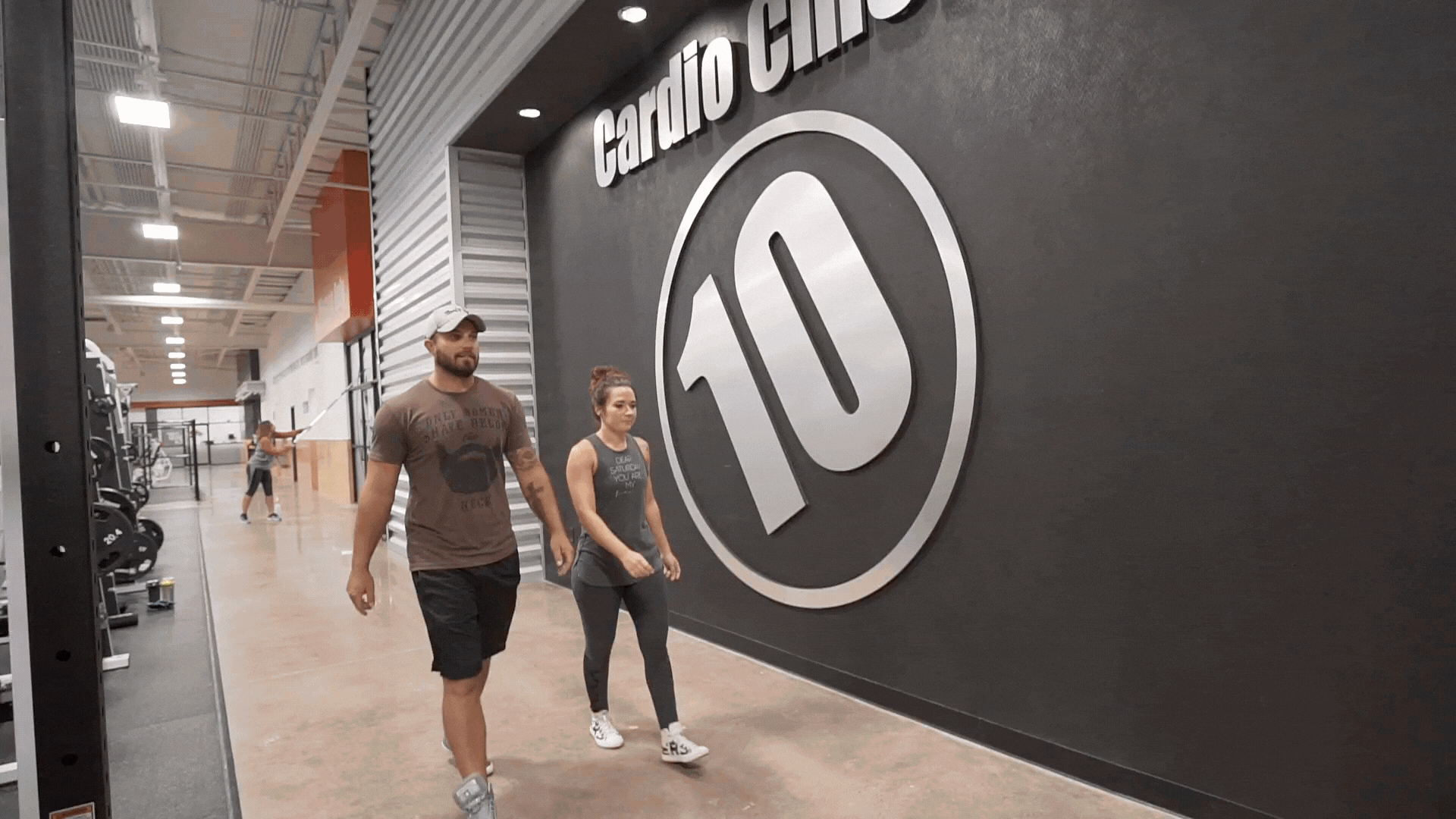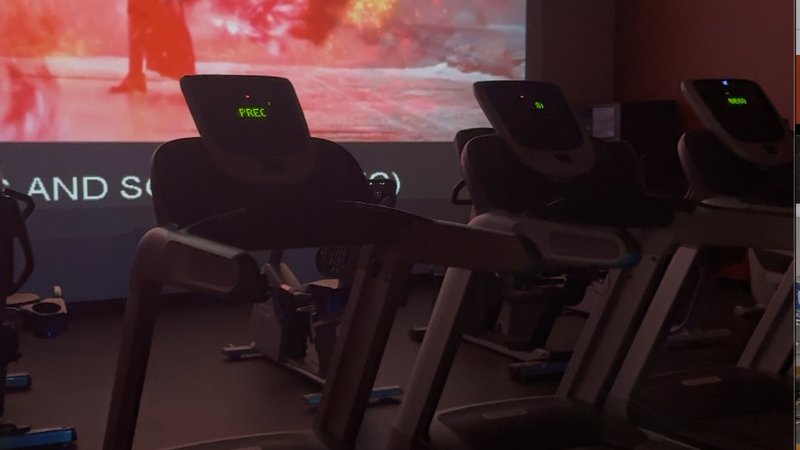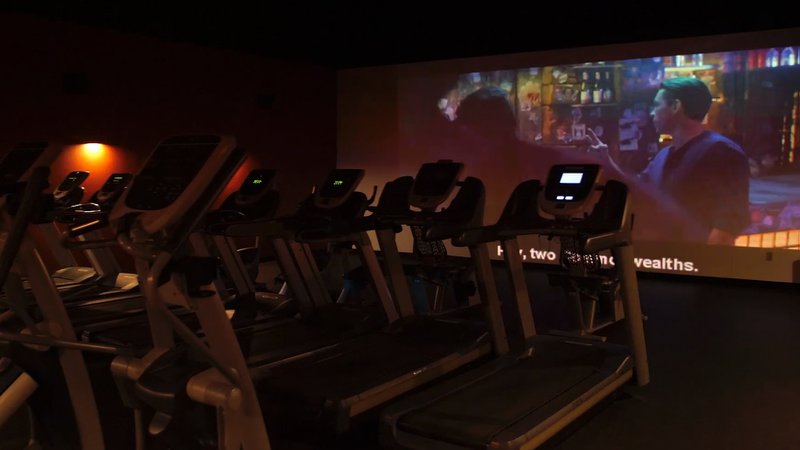
Can watching movies while you exercise help you stay consistent—or throw you off? If you’re trying to get fit without wasting time or motivation, the answer matters. At 10 Fitness, we know people want value, focus, and fun. Mixing exercise with entertainment sounds smart, but is it? We’ll go over when it’s safe to watch movies while working out, when it can be a distraction, and how screen time can support your workout.
Key Takeaways:
- Movies lower perceived effort in low-intensity workouts and help with enjoyment.
- Watching films can reduce body awareness and affect form and focus.
- Action and sports films go well with cardio; motivational films work for strength sessions.
- Comedies pair with light movement; dramas suit cooldowns or yoga.
- Music is more effective than movies for improving focus and workout performance.
- Best machines for movie workouts: treadmills, bikes, and ellipticals.
- Poor screen placement may cause neck/back pain and injury.
- Netflix and Amazon Prime stream reliably on mobile and smart gym gear.
- Use tablets with mounts; avoid holding screens during intense moves.
- Match film genre and pacing with workout length and intensity.
- Scene-based pacing (e.g., move during action, rest during dialogue) keeps you engaged.
- Safe setups: eye-level screens, wireless headphones, steady mounts.
- Group workouts can feature fun "fitness game rules" tied to movie scenes.
The Benefits And Drawbacks Of Choosing To Watch Movies While Working Out
When people commit to fitness, they often look for engaging ways to stay consistent. Because many gym-goers want something entertaining during exercise, they frequently turn to movies. In fact, one of the quickest ways to make time move faster while exercising is to watch movies while working out. Although this habit seems helpful, it has both benefits and drawbacks. Therefore, understanding the impact of movies on focus, motivation, and performance is important before building them into your routine.
Reduced Mental Focus
To begin, movies often pull attention away from form and breathing. Since your eyes typically follow the screen and your mind follows the storyline, you may lose mindful awareness of body signals. Consequently, lapses in concentration can affect posture or timing. Even though workouts are intended to provide mental clarity, movies may instead create noise that interrupts that benefit. Because exercise should balance both movement and reflection, constant distractions may weaken that purpose.
Furthermore, scientific research reinforces this drawback. Findings published in the Proceedings of the National Academy of Sciences show that surprise and excitement from screen content can shift focus and break rhythm. While a thrilling scene grabs attention, it can also disrupt exercise form or foot placement on a treadmill. Unfortunately, this distraction may even increase injury risk. Although some gyms, including 10 Fitness, emphasize safe exercise guidelines and offer dedicated advice on injury prevention strategies, participants are still personally responsible for monitoring form if they watch movies while working out or are otherwise distracted.

Choosing to Watch Movies While Working Out May Make Exercise Feel Easier
On the other hand, movies can also reduce perceived effort. In fact, a 2014 study showed that pairing entertainment with low-intensity motion makes exercise feel less demanding. As a result, beginners might stay active longer by zoning out on a show, and seasoned athletes can use movies to recover while still moving. Because many people struggle to remain motivated during cardio, having a movie lined up often creates the feeling of “time flying.” While the drawback of reduced focus exists, the benefit of easier endurance sometimes outweighs it, depending on the setting. Thus, choosing to watch movies while working out can function as both a barrier and a tool depending on intensity and intent.
Listening To Music Often Outperforms Films
Although films entertain, music can support exercise performance more consistently. Since music generally carries a rhythm, it helps guide pace and intensity. Research from Dr. Thomas Fritz demonstrated how participants used less energy while maintaining effort when listening to rhythm-based tracks. Similarly, many runners lock their stride to beats, improving efficiency. By contrast, movie audio seldom matches exercise rhythm because soundtracks shift between dialogue and action. As a result, mismatched beats may disrupt pace during cardio. While music builds alignment between body and tempo, movies may provide comfort but not synchronization. Therefore, people aiming for specific gains or higher intensity should strategically prioritize soundtracks rather than screens.
Body Mindfulness During Movie Time
If you watch movies while working out, it can create an illusion of lower exertion, which can prove dangerous if you’re not mindful. Because the plot distracts, you may not notice fatigue, tension, or dehydration. Unfortunately, ignoring these signals can eventually increase the risk of strain or overuse injury. On the bright side, this same distraction may keep someone on a treadmill longer, which can improve cardiovascular endurance. Ultimately, trade-offs depend on your goals. If you want intentional control, music or focused workouts may be a stronger option. If you want casual endurance while finishing an episode, movies can serve you well.
Different Movie Genres Match Different Types Of Workouts
When integrating films into your plan, genre selection becomes crucial. For example, action or sports films pair well with fast-paced cardio. Because chase scenes, strong soundtracks, and quick editing create momentum, they naturally elevate heart rate on a treadmill. Moreover, action-heavy films like Mad Max: Fury Road or Rocky encourage viewers to move with intensity. In contrast, personal dramas or inspirational stories such as The Pursuit of Happyness work well for resistance training. Since lifting requires slower concentration yet mental drive, these stories offer motivation without overwhelming speed.
Similarly, comedies support lighter sessions, warming moods, and lengthening endurance. Laughing during lower-stress activities like walking often loosens muscles and decreases stress levels, making sessions more enjoyable. On the opposite side of the spectrum, calming titles such as Forrest Gump or nature documentaries fit yoga or cool-down phases, aligning with relaxation goals. Consequently, matching genre with workout type prevents jarring mismatches and builds a smoother fitness rhythm.
Building A Reliable Workout Movie Playlist Creates Structure
Because movie choice influences rhythm, curating a workout playlist is useful. For example, short comedies like 21 Jump Street provide pacing for short cardio bursts, while longer visual epics like Interstellar hold attention during cycling or rowing. Adding matching elements when you watch movies while working out, like breaking the week into themed sessions—such as “Monday Action,” “Friday Comedy,” or “Sunday Visuals”—creates consistency. When each workout links to a movie theme, commitment rises. Since many gyms like 10 Fitness emphasize routine, playlists allow participants to create a steady structure around both entertainment and training.
Safe Movie-Watching Setups Reduce Injury Risk While Exercising
Because posture matters, safe setup is vital for those choosing to watch movies while working out. Ideally, screens must remain at eye level so the neck stays neutral. For treadmill use, mounting tablets or phones securely prevents bouncing or unsafe positioning. On stationary bikes, clamps on the handlebars create the safest balance. At home, adjustable mounts or lightweight projectors avoid awkward craning that strains the spine.
Additionally, glare reduces comfort and causes unnecessary neck shifts. Therefore, positioning screens away from bright light keeps form stable. Taking cues from professional recommendations and resources like NIH hydration guides also supports safety, especially when distractions lengthen workout time. When setup, lighting, and hydration are considered together, movie sessions can feel both engaging and physically safe.

Choosing The Right Devices And Platforms Improves Workout Flow
Because devices impact convenience, selecting the right equipment determines whether movies enhance or hinder workouts. Tablets strike a balance between portability and visibility, making them practical for treadmills and bikes. Phones are lighter but riskier if not locked and mounted properly. In-home gyms, projectors, or laptops offer immersive options ideal for longer stationary workouts. Additionally, platforms like Netflix, Prime Video, or Disney+ provide large content libraries, with most offering offline downloads for stable playback.
Although some modern cardio machines include built-in streaming services, they may require frequent log-ins or have limited app options. To simplify, Bluetooth headphones paired with reliable tablets or screens often deliver the best results in any environment. Overall, simple, secure, and non-distracting technology enhances rather than interrupts fitness sessions.
Movies Should Match Workout Intensity And Duration
Importantly, the length and pacing of a movie should align with the workout length. A mismatch leaves you finishing too soon or losing rhythm mid-session. Short sitcoms often suit 20-minute workouts, while feature films pair with longer bike rides. Additionally, pacing inside films can serve as natural rhythm cues, guiding intensity during action or allowing recovery during dialogue. Thus, timing movie sessions to mirror both the duration and pacing of exercise maximizes efficiency. For many people, syncing content with exercise creates a psychologically rewarding balance between work and entertainment.
Choosing to Watch Movies While Working Out Can Increase Motivation And Consistency In Fitness Plans
Another benefit is motivational structure. Because stories engage emotion, they help you push through the discomfort. When shows or films are only allowed during exercise sessions, they become rewards that reinforce consistency. Over time, workouts align with viewing schedules and reinforce habits. By pairing entertainment with fitness, participants create a loop that enhances adherence. Since commitment is often the hardest barrier to overcome, using movies strategically can improve long-term fitness outcomes.
Smart Integration Of Movies Enhances Home And Gym Experiences
Although films may distract at high intensity, thoughtful integration strengthens workouts. In group fitness contexts, teams may even design challenges around film timing, such as performing specific moves during pivotal scenes. At home, making themed nights or synchronizing movement with action beats increases engagement. Because gyms like 10 Fitness already promote themed group training and structured classes, adapting those styles to movie-based sessions creates familiarity for participants.
Most importantly, physical setup, hydration, and rest routines should remain priorities. Indeed, adding films should never replace core principles of recovery, nutrition, and proper training technique as detailed in injury prevention strategies. With preparation and balanced priorities, movies can supplement rather than compromise fitness goals.
Different Machines Respond Differently To Watching Movies While Working Out
Not all workout equipment is equally suited for films. Because treadmills, bikes, and ellipticals keep the body position fairly steady, they are ideal for screen use. However, resistance machines and free weights demand more awareness, making movies risky distractions. Lifting requires sustained attention to form, so distracting plots may encourage mistakes or unsafe posture. Therefore, safer integration includes using movies during steady cardio sessions while relying on music or silence during resistance-based or high-intensity efforts. Careful separation between the two maximizes safety and training results.
Expert-Backed Guidelines Ensure Balance Between Focus And Entertainment
Finally, balancing entertainment and purpose ensures sustainable fitness. Experts emphasize movement as an opportunity for mental reset as well as physical development. Therefore, movies should remain complementary, not primary. Using pacing to shape effort or laughter to relieve stress may elevate motivation, but zoning out exclusively risks undermining mindfulness. Even though screens enhance comfort, many experts caution against relying too heavily on them during intense movement because posture and safety can decline. By applying moderation, you can enjoy movies without compromising long-term results.

Watch Movies While Working Out
Ultimately, choosing to watch movies while working out offers both positives and negatives. On one hand, films reduce boredom, disguise effort, and even build consistent habits. On the other hand, they may lessen focus, disrupt rhythm, and increase strain risks if mismanaged. Because safety, preparation, and intentionality matter, pairing the right screen setups and playlists with proper hydration, stretching, and rest strategies ensures balance. Exercisers who use movies carefully can enjoy entertainment without undermining performance. Therefore, when entertainment and structure are aligned, movies can serve as a valuable motivator in a well-rounded fitness plan.
Take Action Toward Smarter Fitness
Your fitness journey deserves both balance and enjoyment, and entertainment can play a role when used wisely. Explore even more safe, effective workout strategies directly with the experts at 10 Fitness, where community, training, and modern equipment await. To protect your progress and avoid setbacks, follow these injury prevention tips. Start today, enjoy your workouts, and build a routine that feels both engaging and sustainable. Your strongest, most consistent fitness lifestyle begins now.

